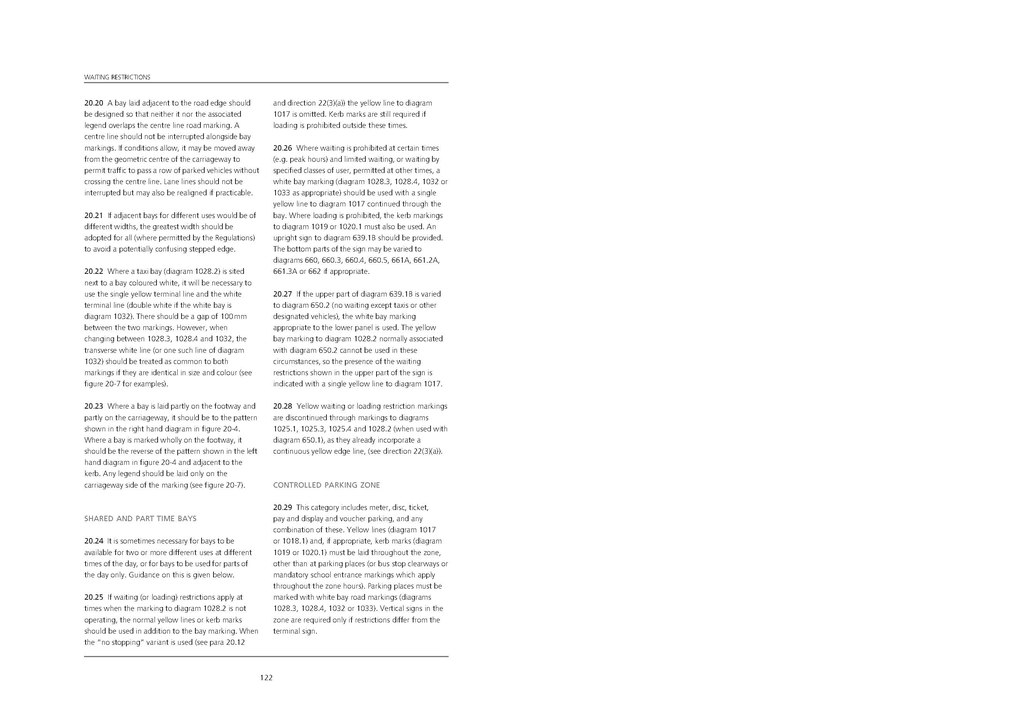20.20 A bay laid adjacent to the road edge should be designed so that neither it nor the associated legend overlaps the centre line road marking. A centre line should not be interrupted alongside bay markings. If conditions allow, it may be moved away from the geometric centre of the carriageway to permit traffic to pass a row of parked vehicles without crossing the centre line. Lane lines should not be interrupted but may also be realigned if practicable.
20.21 If adjacent bays for different uses would be of different widths, the greatest width should be adopted for all (where permitted by the Regulations) to avoid a potentially confusing stepped edge.
20.22 Where a taxi bay (diagram 1028.2) is sited next to a bay coloured white, it will be necessary to use the single yellow terminal line and the white terminal line (double white if the white bay is diagram 1032). There should be a gap of 100 mm between the two markings. However, when changing between 1028.3, 1028.4 and 1032, the transverse white line (or one such line of diagram 1032) should be treated as common to both markings if they are identical in size and colour (see figure 20-7 for examples)
20.23 Where a bay is laid partly on the footway and partly on the carriageway, it should be to the pattern shown in the right hand diagram in figure 20-4. Where a bay is marked wholly on the footway, it should be the reverse of the pattern shown in the left hand diagram in figure 20-4 and adjacent to the kerb. Any legend should be laid only on the carriageway side of the marking (see figure 20-7).
SHARED AND PART TIME BAYS
20.24 It is sometimes necessary for bays to be available for two or more different uses at different times of the day, or for bays to be used for parts of the day only. Guidance on this is given below.
20.25 If waiting (or loading) restrictions apply at times when the marking to diagram 1028.2 is not operating, the normal yellow lines or kerb marks should be used in addition to the bay marking. When the "no stopping" variant is used (see para 20.12 and direction 22(3)(a)) the yellow line to diagram 1017 is omitted. Kerb marks are still required if loading is prohibited outside these times.
20.26 Where waiting is prohibited at certain times (e.g. peak hours) and limited waiting, or waiting by specified classes of user, permitted at other times, a white bay marking (diagram 1028.3, 1028.4, 1032 or 1033 as appropriate) should be used with a single yellow line to diagram 1017 continued through the bay. Where loading is prohibited, the kerb markings to diagram 1019 or 1020.1 must also be used. An upright sign to diagram 639.1B should be provided. The bottom parts of the sign may be varied to diagrams 660, 660.3, 660.4, 660.5, 661A, 661.2A, 661.3A or 662 if appropriate.
20.27 If the upper part of diagram 639.1B is varied to diagram 650.2 (no waiting except taxis or other designated vehicles), the white bay marking appropriate to the lower panel is used. The yellow bay marking to diagram 1028.2 normally associated with diagram 650.2 cannot be used in these circumstances, so the presence of the waiting restrictions shown in the upper part of the sign is indicated with a single yellow line to diagram 1017.
20.28 Yellow waiting or loading restriction markings are discontinued through markings to diagrams 1025.1, 1025.3, 1025.4 and 1028.2 (when used with diagram 650.1), as they already incorporate a continuous yellow edge line, (see direction 22(3)(a)).
CONTROLLED PARKING ZONE
20.29 This category includes meter, disc, ticket, pay and display and voucher parking, and any combination of these. Yellow lines (diagram 1017 or 1018.1) and, if appropriate, kerb marks (diagram 1019 or 1020.1) must be laid throughout the zone, other than at parking places (or bus stop clearways or mandatory school entrance markings which apply throughout the zone hours). Parking places must be marked with white bay road markings (diagrams 1028.3, 1028.4, 1032 or 1033). Vertical signs in the zone are required only if restrictions differ from the terminal sign.
122
